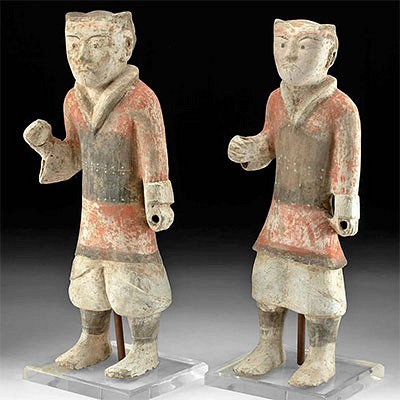20th C. Mali Dogon Hombori Marble Bracelet
Lot 158
About Seller
Artemis Gallery
686 S Taylor Ave, Ste 106
Louisville, CO 80027
United States
Selling antiquities, ancient and ethnographic art online since 1993, Artemis Gallery specializes in Classical Antiquities (Egyptian, Greek, Roman, Near Eastern), Asian, Pre-Columbian, African / Tribal / Oceanographic art. Our extensive inventory includes pottery, stone, metal, wood, glass and textil...Read more
Categories
Estimate:
$700 - $1,050
Absentee vs Live bid
Two ways to bid:
- Leave a max absentee bid and the platform will bid on your behalf up to your maximum bid during the live auction.
- Bid live during the auction and your bids will be submitted real-time to the auctioneer.
Bid Increments
| Price | Bid Increment |
|---|---|
| $0 | $25 |
| $300 | $50 |
| $1,000 | $100 |
| $2,000 | $250 |
| $5,000 | $500 |
| $10,000 | $1,000 |
| $20,000 | $2,500 |
| $50,000 | $5,000 |
| $100,000 | $10,000 |
| $200,000 | $20,000 |
About Auction
By Artemis Gallery
May 25, 2023
Set Reminder
2023-05-25 10:00:00
2023-05-25 10:00:00
America/New_York
Bidsquare
Bidsquare : ON-SALE! Antiquities, Pre-Columbian, Ethno, Fine Art
https://www.bidsquare.com/auctions/artemis-gallery/on-sale-antiquities-pre-columbian-ethno-fine-art-12860
ON-SALE Antiquities, Pre-Columbian, Ethno, More! Artemis Gallery info@artemisgallery.com
ON-SALE Antiquities, Pre-Columbian, Ethno, More! Artemis Gallery info@artemisgallery.com
- Lot Description
West Africa, Mali or Burkina Faso, Dogon or Mossi, ca. mid-19th to 20th century CE. A beautiful Hombori marble bracelet presenting with a thick band, a smooth, rounded exterior, and a conversely rough interior. This gorgeous bangle is naturally adorned in a hue of deep black and dark gray with natural white inclusions throughout, creating a fascinating composition. The much-coveted Hombori marble is mined by the local villagers of Hombori mountain in Mali at quarry sites owned by each village chief. Considered both dangerous and sacred, miners often sacrifice a chicken or sheep before their dig to insure a bountiful yield and a safe return. Though the bracelets were initially made by the local villagers and then traded, the tradition has now spread to many groups throughout western Africa and the Sahara Dessert. These bracelets are believed to serve as good luck charms and have apotropaic capabilities. Size of exterior: 4.6" Diameter (11.7 cm); of interior: 2.8" Diameter (7.1 cm)
Similar examples can be found in the Peabody Museum of Art and Archaeology under accession number 988-18-50/12432 and Christopher D. Roy's "Art of the Upper Volta Rivers" (1987), p. 80. The information on Hombori marble, as well as the quote from the craftsman, was found in the article "Stone Bracelet Production in Mali" by Anne Carmagnani and Pailler Yvan (2009, 'Internet Archaeology', 10.11141/ia.26.16).
Provenance: private southwestern Pennsylvania, USA collection, acquired prior to 2000
All items legal to buy/sell under U.S. Statute covering cultural patrimony Code 2600, CHAPTER 14, and are guaranteed to be as described or your money back.
A Certificate of Authenticity will accompany all winning bids.
We ship worldwide and handle all shipping in-house for your convenience.
#176820Wearable as shown. Expected nicks, chips, and abrasions to surface, but otherwise intact and excellent with beautiful natural striations to stone.Condition
- Shipping Info
-
All shipping is handled in-house for your convenience. Your invoice from Artemis Gallery will include shipping calculation instructions. If in doubt, please inquire BEFORE bidding for estimated shipping costs for individual items.
-
- Buyer's Premium



 EUR
EUR CAD
CAD AUD
AUD GBP
GBP MXN
MXN HKD
HKD CNY
CNY MYR
MYR SEK
SEK SGD
SGD CHF
CHF THB
THB













